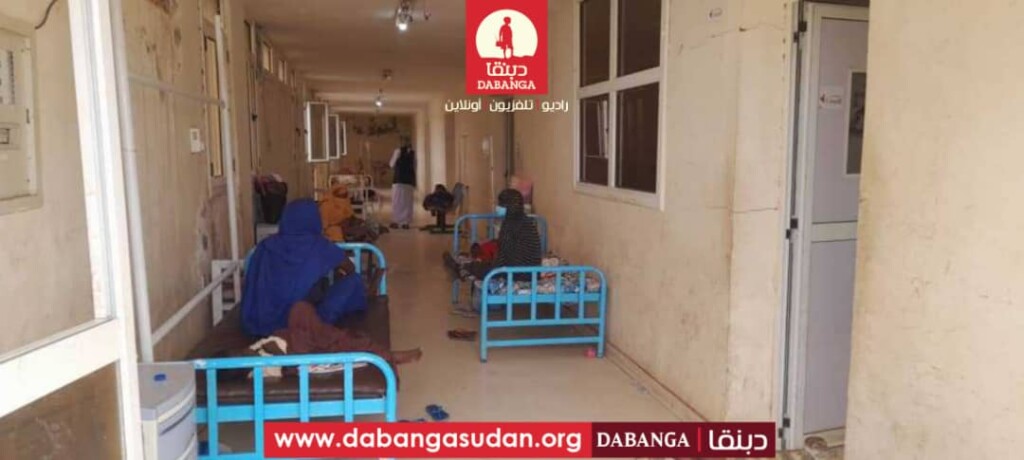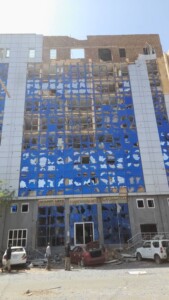Cholera spreads in Sudan – displaced bear the brunt

Cholera patients at Wad El Hilu Rural Hospital in Kassala this year (Photo: Radio Dabanga)
Six people have died, with nearly 400 infected as cholera spreads in large parts of El Gedaref after it was recently nearly eliminated. Most of those infected are displaced people. The Khartoum North/Bahri Emergency Room yesterday reported the spread of cholera, malaria, and malnutrition, among the population of the city, in addition to the emergence of new cases of tuberculosis, but also of diabetes and high blood pressure in October.
Volunteers told Radio Dabanga that the authorities opened isolation centres at El Fao Hospital in western El Gedaref, along the border with El Gezira. The hospital recorded about 177 cases yesterday, 93 cases on Friday, and 128 cases on Thursday, while 164 cases were admitted to the ward and 110 cases were discharged after receiving treatment.
The Health Emergency Department at El Fao Hospital immediately declared a state of emergency and called for help from international humanitarian organisation Médecins Sans Frontières (MSF), which took over work at the hospital’s isolation centre to treat the patients.
They described the health situation in El Gedaref as horribly deteriorating due to the spread of ‘watery diarrhoea’, as cholera is often called in Sudan, after it had been nearly eradicated, as a result of the increasing influx of people fleeing from the eastern parts of El Gezira to El Gedaref. They said that the hospital received large numbers under the supervision of MSF and the El Fao health care authorities.
The epidemic is concentrated in shelter centres for displaced people in El Fao, the sources said. The volunteers appealed to the authorities to open other isolation centres in the area to relieve pressure on the hospital, which is suffering from the influx of large numbers of people suffering from cholera.
They also reported the spread of diseases among the newly displaced of whom many are living rough in El Gedaref city. They are staying in the streets and under trees in a tragic humanitarian situation, as a result of the overcrowding of the shelter camps. “Most of the mosques have been opened, especially in the El Soug El Sha’bi area, but that is not enough with the increasing wave of displacement that has not stopped,” one of the sources said.
The dire health and living conditions forced some of the displaced who fled RSF attacks to consider returning to Sennar and El Dinder. Others preferred to return to eastern El Gezira despite the dangers of being assaulted by the RSF.
“They saw that the situation would not be worse than what they are in now, as they came with only the clothes on their backs and did not carry any money with them to buy their needs. they were unable to find shelter in El Gedaref, but they preferred to return to their villages.”
Medics have warned of the spread of highly contagious epidemics with every wave of displacement, to the point where it would be difficult to control the epidemic. The health authorities are not prepared to receive these large numbers of displaced persons and do not have a plan to combat epidemics and limit their spread, a medic told Radio Dabanga. He did not rule out that the situation would continue at this pace with the continuation of the waves of fleeing people. He said he hopes that these positions should push officials to think about planning from now to improve the health environment in the coming period.
Vaccination:
The Expanded Programme for Immunisation of the federal Ministry of Health stated that cholera vaccination is continuing in Ed Duweim and El Geteina localities in White Nile state, where 65 per cent were vaccinated, El Fao in El Gedaref with a coverage rate of 87 per cent within four days, and in El Managil in El Gezira with a rate of 47 per cent in three days, while it started yesterday in East Sennar.
Khartoum North
The Khartoum North/Bahri Emergency Room yesterday reported the spread of cholera, malaria, and malnutrition, among the population of the city, in addition to the emergence of new cases of diabetes, high blood pressure, and tuberculosis in October.
The Emergency Room said in its October report that the highest rates of malaria infection were recorded at the United Villages Health Centre in Rural Bahri, with about 1,300 cases, followed by the health centre of El Ezba with 963 cases.
High rates of watery diarrhoea/cholera were recorded in all centres, with the United Villages Health Centre having the highest cholera rates, at about 700 cases.
El Ezba reported the highest rate of malnutrition, reaching 112 cases.
The report further pointed to an increase in chronic health problems, and the emergence of new cases of diabetes, high blood pressure and tuberculosis, amidst a shortage of health facilities and services.
“The lack of clean water directly affects the people’s health and personal hygiene, in addition to malnutrition.”
The Khartoum Bahri Emergency Room stressed that the health situation in the city is worrying and requires urgent intervention, warning of an increase in the number of diseases and deaths compared to September. The volunteering medics also stressed the need to increase health coverage by increasing the number of health centres in the areas controlled by the army.
Cholera is an acute diarrhoeal infection caused by eating or drinking food or water that is contaminated with the bacterium Vibrio cholerae. Cholera remains a global threat to public health and is an indicator of inequity and lack of social development. Researchers have estimated that every year, there are 1.3 to 4.0 million cases of cholera, and 21,000 to 143,000 deaths worldwide due to the infection.
The extremely serious disease can cause severe acute watery diarrhoea with severe dehydration. It takes between 12 hours and five days for a person to show symptoms after consuming contaminated food or water. Cholera affects both children and adults and can kill within hours if untreated.
Most people infected with Vibrio cholerae do not develop any symptoms, although the bacteria are present in their faeces for 1-10 days after infection. This means the bacteria are shed back into the environment, potentially infecting other people.
(Source: WHO)











 and then
and then